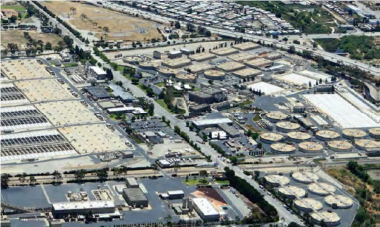Wastewater being used to track COVID-19 infections

A national research team that includes SCCWRP has begun investigating how wastewater influent could be used to monitor the prevalence of COVID-19 infections in communities in near real time.
The study, launched in February and led by researchers at the University of Michigan and Stanford University, will measure the levels of virus entering wastewater treatment plants – with the intent to eventually correlate the data to levels of COVID-19 infections in local populations. Wastewater streams have the potential to offer more comprehensive, accurate insights about community infection rates than targeted testing, which so far has been centered primarily around individuals with illness symptoms.
Researchers hope to design a wastewater surveillance system that can provide an early-warning indicator of increases in COVID-19 community infection rates, providing critical lead time for public health officials. This information also could help governments make better-informed decisions to close businesses and restrict movement in a more targeted fashion.
During the study, researchers will capture the SARS-CoV-2 virus in wastewater influent samples, then use PCR (polymerase chain reaction) technology to quantify the virus’s RNA.
Researchers’ goal is to correlate the virus counts with community infection rates, which will allow public health officials to compare COVID-19 infection data for sewer-sheds across the nation.
To build capacity to translate quantified virus RNA counts into a total number of individuals infected, researchers intend to model multiple scenarios, including how much RNA is shed in fecal material of infected individuals, and how these levels vary by factors such as age, gender and ethnicity. Researchers also plan to model how the virus’s genetic material decays as it moves through sewer systems.
The use of wastewater streams to track infectious diseases in a community is not a novel concept. The approach has been used previously to track polio and salmonella outbreaks.
Furthermore, the SARS-CoV-2 virus already has been measured in wastewater samples. The journal Nature reported in April that more than a dozen research groups around the world have begun working to track the virus in wastewater.
The wastewater study that SCCWRP is participating in is the largest of its kind in the world; samples are being collected at about 50 wastewater plants across the nation. SCCWRP is serving as a study facilitator for eight Southern California wastewater treatment facilities operated by SCCWRP’s four POTW member agencies.
SCCWRP’s role in the study also will include development of advanced measurement methods. SCCWRP, a national leader in the development of the droplet digital PCR (ddPCR) method for water-quality monitoring, will adapt this technology to measure the COVID-19 virus; ddPCR is a more sensitive quantification approach than older, more commonly used PCR techniques.
Study participants began collecting wastewater samples in February. Researchers are working to build sufficient capacity to conduct ongoing COVID-19 surveillance monitoring as early as this fall, which could provide an early-warning indicator of a possible second wave of infection as schools and other gathering places re-open.
For more information, contact Dr. John Griffith.
More news related to: Microbial Source Tracking, Microbial Water Quality, Top News